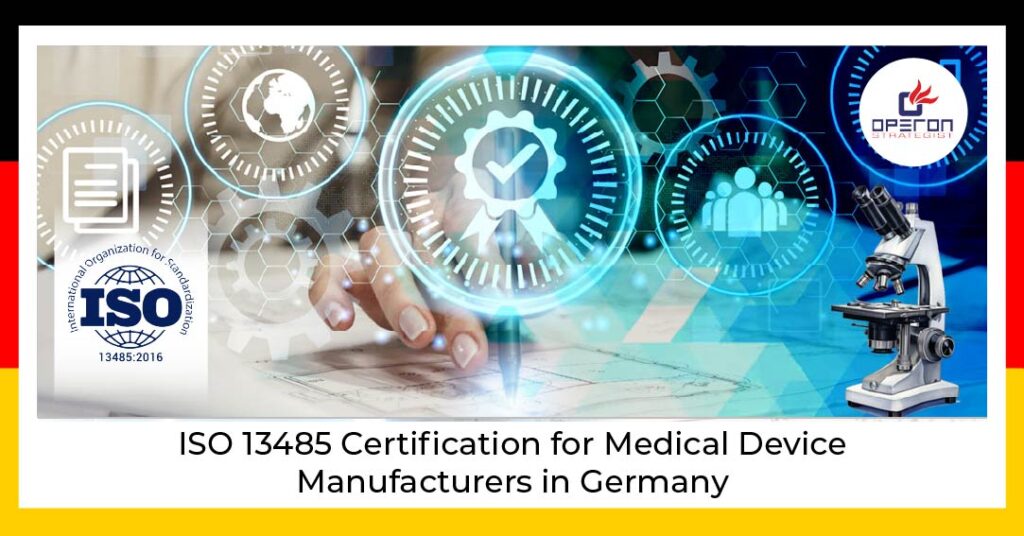Intraocular Lenses (IOLs) are one of the most widely used implantable ophthalmic devices designed to replace the natural lens of the eye, typically after cataract surgery. To market these devices in the European Union — including Germany, a major hub for ophthalmic innovations — manufacturers must obtain the CE Mark for Intraocular Lenses in compliance with EU MDR 2017/745.
The CE Mark demonstrates that the IOL meets stringent safety, performance, and quality requirements as per the European Medical Device Regulation (MDR). This guide explains the step-by-step CE marking process for IOLs, documentation needs, regulatory pathways, and how expert consultants like Operon Strategist can help streamline compliance for German and EU manufacturers.
Let's Grow Your Business Together
What Is a CE Mark for Intraocular Lenses (IOL)?
Lorem ipsum dolor sit amet, consectetur adipiscing elit. Ut elit tellus, luctus nec ullamcorper mattis, pulvinar dapibus leo.
Step-by-Step Process to Obtain CE Mark for Intraocular Lenses
1. Determine Device Classification
Under MDR 2017/745, Intraocular Lenses are classified as Class III implantable devices, requiring a comprehensive conformity assessment. This step determines the applicable route for CE marking and sets the foundation for all subsequent processes.
2. Implement a Quality Management System (QMS)
Manufacturers must establish a QMS compliant with ISO 13485. This system ensures consistent product design, manufacturing, and control processes. In Germany, regulatory bodies and notified bodies prioritize robust QMS implementation before any technical review begins.
3. Conduct Clinical Evaluation and Performance Studies
Clinical evaluation for IOLs must comply with Annex XIV of MDR 2017/745. Manufacturers need to provide data on biocompatibility, optical performance, mechanical stability, and postoperative outcomes. When existing data is insufficient, clinical investigations must be conducted in line with ISO 14155 standards.
4. Prepare Technical Documentation
The technical documentation (as per Annex II and III of MDR) must include:
Device description and specifications
Design and manufacturing information
Risk management file (as per ISO 14971)
Verification and validation data
Clinical evaluation report (CER)
Post-market surveillance (PMS) plan
Comprehensive and well-structured documentation is key for notified body assessment and CE certification approval.
5. Engage a Notified Body
For Class III IOLs, manufacturers must work with a designated Notified Body authorized under MDR 2017/745. The Notified Body will audit the manufacturer’s QMS and evaluate the technical documentation, clinical data, and product safety performance before issuing the CE certificate.
6. Compile the EU Declaration of Conformity
Once compliance is verified, the manufacturer prepares the EU Declaration of Conformity (DoC). This legal document declares that the product meets all applicable requirements of MDR 2017/745.
7. Affix the CE Marking
After receiving the CE certificate and completing the DoC, the manufacturer may affix the CE Mark to the device and packaging. This step officially authorizes the IOL for sale in Germany and other EU countries.
Regulatory Considerations for IOL Manufacturers in Germany
Germany’s Federal Institute for Drugs and Medical Devices (BfArM) oversees the market surveillance of medical devices. Manufacturers and authorized representatives in Germany must ensure:
Compliance with German Medical Device Implementation Act (MPDG)
Timely registration in EUDAMED database
Proper vigilance reporting for incidents and field safety corrective actions
Having a German Authorized Representative (EC REP) is essential for non-EU manufacturers to maintain compliance within Germany.
Key MDR Requirements for IOLs
Material Biocompatibility: IOL materials (e.g., hydrophobic acrylic, silicone, PMMA) must pass cytotoxicity and sensitization tests.
Optical Performance: Verification of power accuracy, resolution, and stability over time.
Sterilization Validation: Compliance with ISO 11135 or ISO 17665 for ethylene oxide or steam sterilization.
Labeling and UDI: MDR-compliant labeling with Unique Device Identification (UDI) for traceability.
Post-Market Surveillance: Continuous monitoring and reporting of adverse events through PMS and PMCF (Post-Market Clinical Follow-up).
Role of Operon Strategist in CE Marking for IOLs
At Operon Strategist, we provide comprehensive consulting services to help manufacturers and innovators in Germany achieve CE Mark for Intraocular Lenses efficiently. Our experts support you through:
Device classification and MDR gap analysis
Technical documentation and CER preparation
QMS implementation (ISO 13485)
Clinical investigation guidance
Notified Body coordination and submission support
Post-market compliance and vigilance setup
With over a decade of experience in medical device regulatory consulting, we ensure a seamless and compliant pathway to market approval for ophthalmic and implantable devices.


